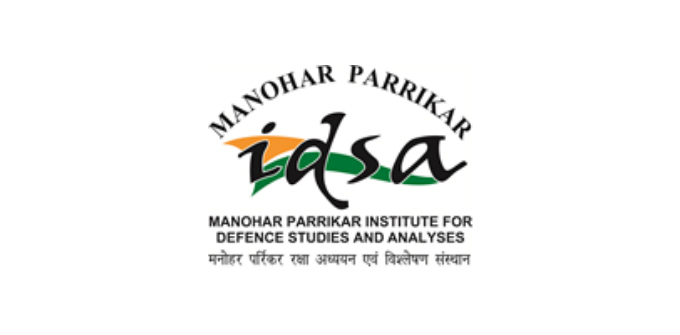
- This event has passed.
Monday Morning Meeting on Cyber Security Risks to Space Assets

Report of the Monday Morning Meeting on “Cyber Security Risks to Space Assets”
Mr. Rohit Sharma, Research Analyst, Manohar Parrikar Institute for Defence Studies and Analyses (MP-IDSA), spoke on “Cyber Security Risks to Space Assets” during the Monday Morning Meeting held on 29 September 2025. The session was moderated by Ms. Khyati Singh, Research Analyst, MP-IDSA. Ambassador Sujan R. Chinoy, Director General, MP-IDSA, and scholars of the Institute attended the meeting.
Executive Summary
The session highlighted the growing centrality of satellite systems in everyday civilian, economic, and military life and the escalating cyber security vulnerabilities targeting these assets. The presenter discussed the risks posed by legacy systems, increase in commercial mega-constellations, and gaps in global governance over space cyber threats. Emphasis was placed on both kinetic and non-kinetic forms of attack, with examples such as jamming, spoofing, supply chain vulnerabilities, and recent high-profile incidents affecting Indian and foreign assets. Recommendations for enhanced policy frameworks, technological innovation, and coordination among Indian defence and civilian cyber agencies were discussed to reinforce the resilience of India’s critical space infrastructure.
Detailed Report
Ms. Khyati opened the session by introducing the topic and highlighting the importance of cyber security in the space domain. She noted that while satellites underpin global connectivity—from navigation and communication to surveillance and banking—their vulnerability to silent, non-kinetic attacks such as jamming, spoofing, and malware insertion poses significant risks to both civilian and military operations.
Mr. Rohit Kumar Sharma began his presentation by discussing the growing dependence on space networks in both civilian and defence sectors. He described the architecture of space networks which comprises satellites, ground stations, user terminals, and communication links. The increasing complexity, proliferation of satellites via mega-constellations, and growing commercialisation, with the rise of companies like SpaceX, has expanded the threat surface. He observed that while over 12,000 satellites are currently in orbit, nearly two-thirds belong to private players like SpaceX which further complicates global governance and security efforts.
Discussing the strategic appeal of cyberattacks, he noted that these operations offer cost-effective, debris-free alternatives to kinetic anti-satellite (ASAT) strikes, allowing actors to disrupt networks without attribution. The speaker then elaborated on the unique risk features in space networks relative to terrestrial systems: Remoteness and physical inaccessibility, which limit security upgrades for satellites; long operational lifespans and legacy systems, often using outdated, non-patchable technology; complex supply chains, that introduce many points of cyber vulnerability; states and non-state actors have been exploiting these for both direct and indirect gains, with attacks ranging from kinetic ASAT strikes to jamming, spoofing, and malware targeting critical communications.
The Speaker also drew attention to the ICARUS Matrix, a framework developed by the California Polytechnic Institute to simulate potential cyberattack scenarios in space. The matrix identified 42 hypotheticals, but plausible attack scenarios, such as compromised 3D printers used for in-orbit repairs and falsified planetary probe data. He then outlined some real time incidents, such as the 2011 jamming of Thuraya satellite telecommunications by Libya, Russia’s alleged spoofing of US drones, and daily cyberattacks reportedly faced by ISRO.
Elaborating on India’s Cyber Security landscape response, the speaker reviewed the country’s evolving cyber governance architecture which includes several security policies, statutes, as well as a number of agencies. He discussed the role of the Computer Emergency Response Team (CERT-In), the National Critical Information Infrastructure Protection Centre (NCIIPC), Defence Cyber Agency, and the National Cyber Coordination Centre (NCCC). He also cited recent legislative initiatives such as the Digital Personal Data Protection Act 2023 and the Telecom Cybersecurity Rules 2024. He also mentioned InSpace’s recent guidelines for private ground-station vendors, reinforcing the focus on supply chain and endpoint security standards as well as India’s plan to develop “Bodyguard Satellites” to defend critical satellites through co-orbital protection mechanisms.
He concluded with a set of best practices for securing space systems, including supply chain management through zero-trust frameworks, data encryption, endpoint protection, regular security audits, and network segmentation. He further emphasised employee training, incident response planning, and the need for India to invest in quantum key distribution (QKD) and post-quantum cryptography to future-proof its systems.
Mr. Rohit concluded his presentation by emphasizing how outer space is a vital security domain which requires constant adaptation to evolving threats. With AI and new technologies reshaping risks, defenders must adopt updated threat models and understand both actor motivations and system vulnerabilities to safeguard critical space assets.
Questions and Comments
Ambassador Sujan R. Chinoy, Director General, MP-IDSA commended the speakers for addressing a subject which is both complex and underexplored in security studies. It was observed that future warfare will increasingly be shaped by technology and network-centric operations rather than traditional force deployment.
Dr. Ajey Lele, Deputy Director General, MP-IDSA, expanded on the operational aspects of jamming and spoofing, noting that uplink jamming poses a greater threat due to its potential to seize control of satellites, whereas downlink jamming affects limited geographic areas. China and Russia’s collaboration in developing advanced cyber-electromagnetic weapons was highlighted as also the global shift towards quantum-based communication as a countermeasure.
It was noted that the United States is already investing in post-quantum cryptography, preparing for a future where quantum technologies themselves may be exploited and India must accelerate its efforts in this domain to avoid falling behind technologically.
Questions were directed towards the speaker about the institutional mechanism coordinating India’s cyber defence across civilian, private, and military domains. In response, the speaker explained that while National Cyber Coordination Centre (NCCC) serves as the primary interface between government and defence agencies, bodies such as CERT-In and sectoral CERTs handle operational coordination. The Defence Cyber Agency, he noted, has both defensive and potential offensive mandates, though the latter remains opaque.
Other interventions emphasized how, like critical terrestrial infrastructure, many space systems rely on outdated software that is difficult to update without causing operational downtime. It was clarified that DRDO and ISRO are already working on relevant systems, implying contingency or backup measures are under development. Though India does not yet have a fully operational backup satellite mechanism, efforts are ongoing within DRDO and ISRO to strengthen resilience and incorporate guidance and redundancy schemes into future systems.
To a question about the trajectory of cyber diplomacy, asking whether India is benefitting from such engagements and how its capabilities compare to Pakistan and China, given China’s use of artificial intelligence (AI) in cyber operations, the speaker explained that although India participates in global forums like the Open-Ended Working Group (OEWG) and the UN Group of Governmental Experts (GGE), there has been limited dialogue specifically addressing cybersecurity in space.
To a question about the intersection of cybersecurity and artificial intelligence in the health sector, particularly with the emergence of remote surgeries, the speaker noted that AI-driven healthcare systems fall within the digital governance domain and are vulnerable to threats such as data poisoning, pointing towards the need to embed cybersecurity measures into AI model design.
To a question about the role of non-state actors in compromising cyber infrastructure in South Asia and India’s preparedness to respond, the speaker mentioned several ransomware incidents, including the AIIMS breach, as an example of infiltration by non-state actors. He noted that such actors often publicise their operations on encrypted platforms like Telegram, though many operate as proxies for state-sponsored groups.
Ms Khyati concluded the discussion by pointing towards how most non-state cyberattacks are indirectly supported by state entities and work as proxy actors on their behalf, seeking plausible deniability, pointing to China and North Korea as prime examples of this tactic.
___________________________________________________________________________
Report prepared by Ms. Ishanya Sharma, Intern, North America and Strategic Technologies Centre, MP-IDSA, New Delhi.



